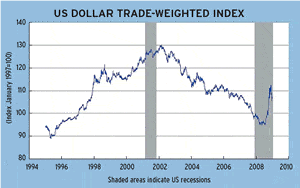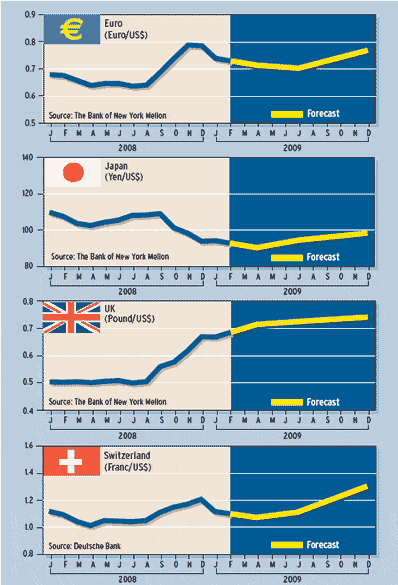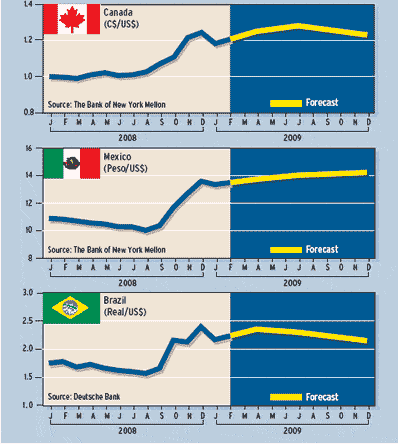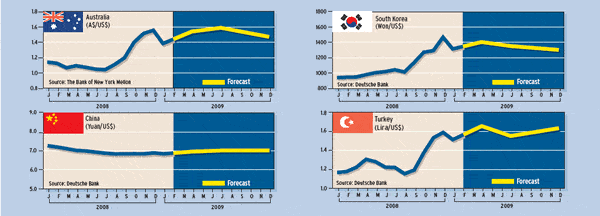 |
“It’s the start of a new year, and this year will turn out fine,” says Michael Malpede, market analyst at online foreign exchange trading system Easy-Forex US, based in Chicago. “Fiscal policy was key to ending the Great Depression, and Obama’s fiscal stimulus plans will be key to ending the current recession,” he says.
The massive fiscal stimulus plans coming from the US government, Canada and Japan, coupled with declining credit-market stress and the sharp drop in energy prices, may spark a quicker economic rebound than many forecasters predict, according to Malpede. “The US was the first to cut rates and react to financial market stress,” he says. “We may find the US leading the global economic recovery sooner than the pundits expect.
Resurgent demand from China and other emerging markets will boost demand for commodities, Malpede says. “The markets will bottom long before the recession ends,” he says. “Commodities and stocks will rally in 2009, and the dollar will emerge as the preferred funding currency.
Reason for Optimism in New Year
Human beings tend to see the start of each calendar year in terms of a new beginning, and there is some reasonable logic to being optimistic this year, says David Gilmore, economist and partner at Foreign Exchange Analytics, based in Essex, Connecticut. “Washington may get it more right on the policy front in 2009 than it did in 2007 and 2008 and actually keep the economy from falling into the black hole of deflation,” he says.
Obama, with an electoral mandate, is planning the largest fiscal stimulus since the 1950s in an attempt to get the economy growing again by filling the gap the private sector is leaving as households and firms pull back in the face of a serious recession, according to Gilmore.
With the Troubled Asset Relief Program (TARP) balance at $350 billion and plans from the Obama administration to add another $900 billion or more in new spending and/or tax cuts, there is serious firepower aimed at the economy, Gilmore says.
Meanwhile, the Federal Reserve will be expanding its balance sheet, or essentially printing money, by buying securities directly from the market. “Moreover, the policy response is global—every major economy is throwing fiscal and monetary accommodation at this problem—and will up the odds of the response working,” Gilmore says. “So I am of the belief that riskier assets and currencies should outperform, at least through the first quarter [of 2009] and possibly the second quarter. If I had to guess, the Obama honeymoon ends in late second quarter and sets the stage for new lows in equities in the second half of 2009 and a rebound in risk-free assets,” he says.
Foreign Rate Cuts Help Dollar
  |
While the Bank of Japan has no room left to cut interest rates, the yen is also due for a big drop against the dollar, according to Weinberg. Year-end paydowns of carry trades generated massive purchases of yen by foreigners, but this is unlikely to continue, he says. “Thus, we expect the yen to turn the corner and to dive against the dollar early this year,” he says. Carry trades involve borrowing in low-yielding currencies to invest in higher-yielding currencies.
Elsewhere in Asia, China’s economy is huge, stable and immune to most of the effects of the global financial crisis, Weinberg says. He forecasts that China’s gross domestic product will grow in excess of 9% in 2009 and will contribute more to world GDP growth this year than any other country.
Only 8% of China’s GDP is generated by net exports, Weinberg says, and the Chinese government already has taken steps to reverse the profit crisis in the export sector. In addition to halting the appreciation of the yuan since last June, the government has reinstated a VAT (value-added tax) rebate for exported goods, and raw-material costs have fallen.
Not Waiting for Wal-Mart
“China’s 1.3 billion people are not just sitting around waiting for another order for toys from Wal-Mart,” Weinberg says. China’s economy will not contract in any quarter this year, and the country’s importance to the world economy will rise, he says. “Make no doubt about it: [China’s] exports are slowing,” he says. “A crisis of profits in that sector will cause job losses, but the domestic economy is still booming, and fiscal stimulus will offset most of the losses from exports. ”
In December 2008 China’s State Council allowed some trade transactions with Hong Kong to be settled in yuan, foreshadowing the possible emergence of that city as a center for yuan trading in the future. In addition, Chinese officials will allow companies to increase the advance purchase of foreign currencies for payment of import bills.
“Both of these measures are consistent with the gradual liberalization of the currency regime that Chinese officials have promised,” says Marc Chandler, global head of currency strategy at Brown Brothers Harriman in New York. Many observers have become more skeptical of promised changes in recent months, as the yuan has stopped appreciating against the dollar, he says.
China’s $1.9 Trillion Reserves
The 12-month NDF (non-deliverable forward) contract suggests that the market is pricing in a 2.5% depreciation of the yuan this year, Chandler says. China’s reserves stood at $1.9 trillion at the end of the third quarter of 2008, and the country’s still-strong trade surplus warns of further reserve accumulation, he says.
“Strong reserve growth will likely be greeted by the incoming US Treasury team as a compelling reason why pressure should continue for China to allow the yuan to appreciate,” Chandler says. Obama frequently criticized Beijing during the 2008 US presidential campaign for manipulating its currency to gain an edge in trade.
As the dollar rose against the major currencies in early January, Chandler says the fundamental reason was more a case of negative developments abroad, particularly in Europe, rather than of positive developments in the United States. One potential problem the dollar may encounter in 2009, he says, could be a lack of strong buying for the flood of US treasury securities in the fiscal year that began on October 1, 2008. The Treasury Department anticipates around $2 trillion in debt sales this year.
Yu Yongding, a former member of the policy board of China’s central bank, who is now an academic, has criticized Beijing’s heavy purchases of US government bonds. In an article in the China Securities Journal in January, Yu said China should sell some of its US treasury securities and increase its euro and yen assets.
“The US budget deficit may reach 10% of gross domestic product in 2009, with the supply of US government bonds significantly exceeding demand,” Yu said. “If China were to then sell treasuries, the clash of interests between the two countries would be serious,” he said, urging that China should quickly diversify its reserves.
Mutually Assured Destruction
Will China soon be a net seller of US treasuries if the United States continues to reflate its way out of recession? “I doubt it,” says Gilmore of Foreign Exchange Analytics. “This is a bargaining chip and one that the Chinese can’t afford to play,” he says.
China would not run the risk of letting the US government and currency fail by divesting out of dollars, according to Gilmore. “It is an unacceptable outcome and one that falls under [the category of] mutually assured financial destruction,” he says.
“While printing money at the Fed to buy debt issued by the US Treasury is unsustainable, the process can and will proceed for a lot longer than anyone thinks before it becomes problematic,” Gilmore says.
In the midst of a global economic slowdown the likes of which the world has not seen since World War II, now is not the time for China to throw out the existing economic model for a new one, Gilmore says. “China has a reason to raise this threat, through surrogates, as it faces pressure from the US to address environmental, labor and human rights problems,” he says. At the most, China will reduce the amount of treasuries it buys and purchase other countries’ sovereign debt and currencies in the future, he says.
Yen Parties Like It’s 1999
For the Japanese yen, 2008 was its strongest year since 1999, measuring its performance against the price of gold, according to Ashraf Laidi, chief market strategist at CMC Markets, based in London. The Swiss franc came in second in gold terms last year, followed by the dollar.
“It is no coincidence that both the yen and the Swiss franc were [also] the two top-performing currencies in 1999,” Laidi says. “Recall that in 1999 the global economy reeled from the Asian and Russian crises,” he says. As in 2008, there was tumultuous volatility in 1999, as well as slumping commodity prices. “As a result, currency markets favored the lower-yielding currencies of Japan and Switzerland purely as a risk-aversion play,” he says.
Despite gold’s sharp slide in the second half of last year, the precious metal showed significant gains against all major currencies in 2008, with the exception of the yen, against which it fell by 5%. In dollar terms, gold rose by 15%, despite its slide from a high of $1,030 an ounce last March.
Have Commodity Prices Hit Bottom?
“Commodity prices reached dizzying heights last year before the speculative bubble popped and prices came crashing down,” says Paul Lennox, corporate treasurer at Custom House, a provider of global payment services that is based in Victoria, British Columbia, Canada. “The parabolic run-up in commodity prices the past few years was panic driven, as everyone was convinced that the world was fast running out of hard assets because of growing demand in the developing world,” he says.
The closely watched Reuters/Jefferies-CRB index of commodity prices fell 56% through December 2008 from its high in July last year, as petrochemical, metal, agricultural and other commodities tumbled. “With prices having fallen so far so fast, odds are that commodity prices have bottomed, even though the global recession is just getting started,” according to Lennox. “One very positive aspect of the commodity-price collapse is that the current low prices will aid the eventual economic recovery, which will in turn gradually lead to increasing demand for commodities,” he says. “People have more discretionary income than they would otherwise have. This is especially true in low-debt countries like China, India and other developing countries,” he says.
Low commodity prices, in addition to the flood of dollars unleashed by the Fed, will likely allow the global economy to establish a bottom by the middle of 2009, according to Lennox. At that point, the dollar will be vulnerable, as market risk aversion abates and investment capital starts flowing once again to the high-growth, fast-developing countries, he says. With a weakening dollar, commodity prices should tend to rise, and this will boost the currencies of commodity-producing countries such as Canada, Australia and Mexico, he says.
US Borrowing Spree
“Many analysts expect the US to lead the world out of recession. This may occur, given the United States’ propensity for borrowing and spending, but we may very well see the US come out of this recession relatively weaker on a comparative basis, simply because it will be even more, and not less, dependent on foreign credit,” Lennox says.
This relative economic weakness will be reflected in the value of the dollar, according to Lennox. “The dollar has recently benefited from a panicked flight to safety,” he says. “Going forward, we will likely see much of those dollar gains given back as risk appetite increases once again and investors seek positive real returns on their capital.” Holding zero-interest, devaluing dollars will soon lose its appeal, he predicts.
Obama’s stimulus plan totaling nearly $1 trillion will be financed primarily by new US borrowing, says Laidi of CMC Markets. “It is erroneous to claim that these aggressive stimulus measures by the Fed and the next Treasury will serve as long-term positives for the dollar simply on the premise of aggressive stimulus [promoting fast growth] while ignoring the deterioration of fiscal imbalances and eroding value of fiat money once the global recovery emerges,” he says. Fiat money is currency that is not backed by any physical commodity, such as gold.
Leading the Way Forward
With a large supply of sovereign bonds coming to market amid historically low yields, there is little wonder why some investors are talking about a bond market bubble, says Chandler of Brown Brothers Harriman. “It is very early in the process, but there have been some potentially revealing developments,” he says. For example, a German government bund auction of more than $8 billion of 10-year bonds on January 7 had a bid-cover ratio of only 1.3, he says, and the Bundesbank itself had to buy almost a third of it or face a failed auction. “Indeed, the risk is that more than one government will face the prospects of failed auctions,” Chandler says.
As the deleveraging forces wind down and risk aversion wanes, the dollar and the yen may see some of their gains from the second half of last year unwind, according to Chandler. “However, we do not anticipate a new bear market for the dollar,” he says. “Instead, after a period of consolidation, we expect the dollar’s uptrend to resume.”
The dollar’s rise may be fueled by traditional cyclical factors, Chandler says. “The aggressiveness of monetary and fiscal response, as well as the business-friendly thrust, makes the US the most likely candidate to lead the economic recovery,” he says.
 |
Gordon Platt



